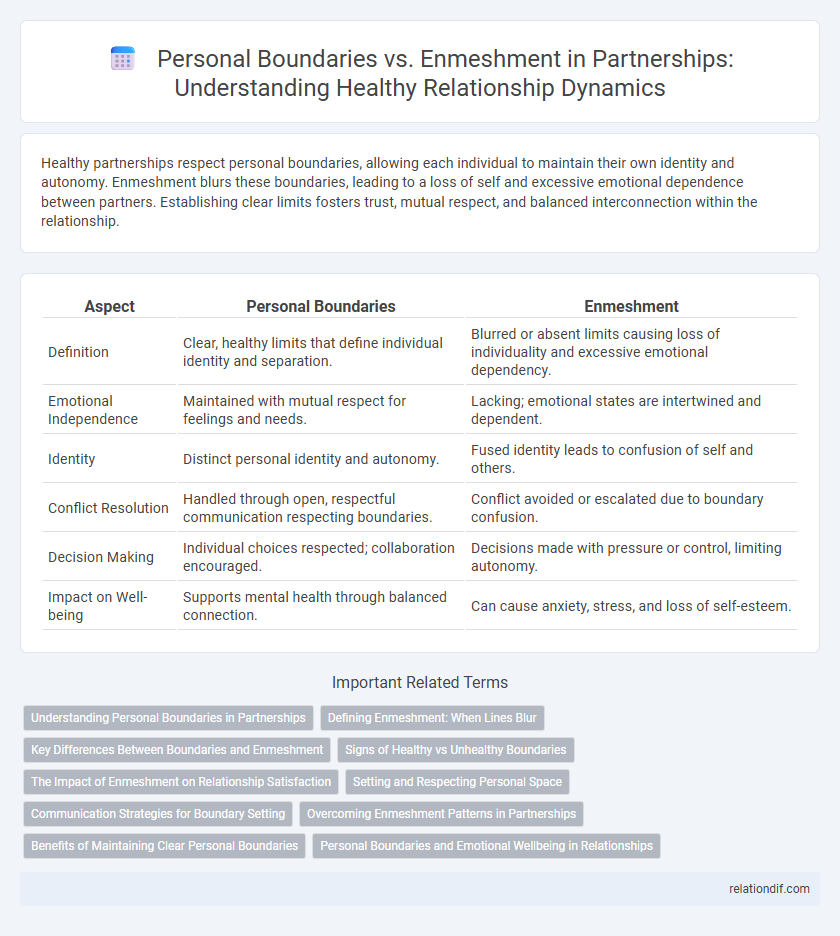Healthy partnerships respect personal boundaries, allowing each individual to maintain their own identity and autonomy. Enmeshment blurs these boundaries, leading to a loss of self and excessive emotional dependence between partners. Establishing clear limits fosters trust, mutual respect, and balanced interconnection within the relationship.
Table of Comparison
| Aspect | Personal Boundaries | Enmeshment |
|---|---|---|
| Definition | Clear, healthy limits that define individual identity and separation. | Blurred or absent limits causing loss of individuality and excessive emotional dependency. |
| Emotional Independence | Maintained with mutual respect for feelings and needs. | Lacking; emotional states are intertwined and dependent. |
| Identity | Distinct personal identity and autonomy. | Fused identity leads to confusion of self and others. |
| Conflict Resolution | Handled through open, respectful communication respecting boundaries. | Conflict avoided or escalated due to boundary confusion. |
| Decision Making | Individual choices respected; collaboration encouraged. | Decisions made with pressure or control, limiting autonomy. |
| Impact on Well-being | Supports mental health through balanced connection. | Can cause anxiety, stress, and loss of self-esteem. |
Understanding Personal Boundaries in Partnerships
Understanding personal boundaries in partnerships is essential for maintaining individuality and mutual respect, preventing enmeshment where partners lose their sense of self. Clear communication about limits and needs fosters a healthy dynamic, allowing both individuals to support each other without overstepping emotional or physical space. Establishing these boundaries enhances trust, reduces conflicts, and promotes long-term relationship satisfaction.
Defining Enmeshment: When Lines Blur
Enmeshment occurs when personal boundaries become indistinct, leading to a loss of individual identity within a partnership. This blurred boundary results in excessive emotional involvement and dependency, hindering healthy autonomy. Recognizing enmeshment is crucial for establishing clear limits that foster mutual respect and personal growth.
Key Differences Between Boundaries and Enmeshment
Personal boundaries involve maintaining individual identity and emotional autonomy within a partnership, allowing each person to express needs and preferences without feeling overwhelmed. Enmeshment blurs these lines, leading to excessive emotional entanglement where partners lose their sense of self and become overly dependent. Key differences include respect for personal space, healthy communication, and the ability to balance closeness with independence.
Signs of Healthy vs Unhealthy Boundaries
Clear personal boundaries in a partnership promote respect, trust, and individual autonomy, indicated by open communication, mutual support, and comfort with personal space. Signs of unhealthy boundaries or enmeshment include excessive dependence, loss of individuality, and difficulty expressing personal needs without fear of conflict. Recognizing these distinctions fosters emotional well-being and strengthens the partnership's foundation.
The Impact of Enmeshment on Relationship Satisfaction
Enmeshment blurs personal boundaries, leading to a loss of individual identity within partnerships and negatively impacting relationship satisfaction. When partners become overly dependent on each other for emotional support, it restricts personal growth and creates imbalance. Maintaining clear boundaries is essential for fostering mutual respect and long-term relationship fulfillment.
Setting and Respecting Personal Space
Establishing clear personal boundaries in a partnership prevents enmeshment and fosters individual autonomy, which is essential for a healthy relationship dynamic. Respecting each partner's personal space allows for emotional resilience and mutual respect, reducing conflicts and promoting trust. Consistent communication about needs and limits ensures boundaries are honored, reinforcing a balanced connection between intimacy and independence.
Communication Strategies for Boundary Setting
Effective communication strategies for setting personal boundaries in partnerships prioritize clear, honest dialogue that respects individual needs and limits. Using "I" statements to express feelings and expectations minimizes misunderstandings and prevents enmeshment by reinforcing personal autonomy. Consistent boundary reinforcement and active listening foster mutual respect and emotional safety, essential for healthy relationship dynamics.
Overcoming Enmeshment Patterns in Partnerships
Overcoming enmeshment patterns in partnerships requires establishing clear personal boundaries to maintain individuality while fostering connection. Recognizing and respecting each partner's emotional needs and space prevents codependency and promotes healthy interdependence. Effective communication and self-awareness serve as key tools in differentiating between supportive closeness and unhealthy enmeshment.
Benefits of Maintaining Clear Personal Boundaries
Maintaining clear personal boundaries in a partnership fosters mutual respect and supports individual autonomy, preventing emotional enmeshment that can blur identities. Clear boundaries enhance communication, reduce conflict, and promote healthy interdependence by allowing partners to express needs without fear of overstepping. Establishing these limits strengthens trust and emotional well-being, creating a balanced and resilient relationship.
Personal Boundaries and Emotional Wellbeing in Relationships
Personal boundaries in partnerships establish clear limits that protect individual emotional wellbeing and foster mutual respect. Maintaining healthy boundaries prevents enmeshment, which can lead to codependency and blurred personal identities. Prioritizing self-awareness and communication supports emotional balance and strengthens relationship resilience.
personal boundaries vs enmeshment Infographic

 relationdif.com
relationdif.com